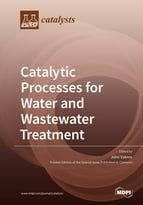Catalytic Processes for Water and Wastewater Treatment
A special issue of Catalysts (ISSN 2073-4344). This special issue belongs to the section "Environmental Catalysis".
Deadline for manuscript submissions: closed (30 November 2022) | Viewed by 34404
Special Issue Editor
Interests: preparation; characterization and testing of supported catalysts; environmental friendly processes; advanced oxidation processes; biochar applications; acid-base behavior of nanoparticles; potentiometric mass titrations; metal support interactions
Special Issues, Collections and Topics in MDPI journals
Special Issue Information
Dear Colleagues,
Water and wastewater treatment are still facing significant challenges today. Due to climate change, water shortages are already noticeable in many regions of the world. To overcome these problems, alternative water sources must be generated and used, for example, treated wastewater, rainwater, surface water, etc. These water sources have to be treated before use since the development of highly sensitive methods reveals the presence of hazardous compounds in low concentrations. These pollutants should be removed, and many processes have been proposed for their degradation/removal, among them catalytic methods. Those where catalysts are in solid form in particular exhibit significant advantages.
Catalytic oxidation or reduction processes are among the most efficient processes. These include photocatalysis, sulfate. and hydroxyl-radical-based advanced oxidation processes.
Therefore, the aim of this Special Issue is to present recent progress and advances in catalytic processes in water and wastewater treatment. This includes but is not restricted to the use of catalysts in the oxidation of organic contaminants, preparation of new supported catalysts, and application in electrode construction for electro-catalytic processes. Finally, new catalytic applications and comparison with other similar catalysts are strongly welcomed.
I kindly invite you to submit a high-quality contribution to this Special Issue of Catalysts entitled “Catalytic Processes for Water and Wastewater Treatment” and to discuss the recent developments in the field. Review and original research articles are all welcome. Experimental as well as theoretical inquiries will be included.
Dr. John Vakros
Guest Editor
Manuscript Submission Information
Manuscripts should be submitted online at www.mdpi.com by registering and logging in to this website. Once you are registered, click here to go to the submission form. Manuscripts can be submitted until the deadline. All submissions that pass pre-check are peer-reviewed. Accepted papers will be published continuously in the journal (as soon as accepted) and will be listed together on the special issue website. Research articles, review articles as well as short communications are invited. For planned papers, a title and short abstract (about 100 words) can be sent to the Editorial Office for announcement on this website.
Submitted manuscripts should not have been published previously, nor be under consideration for publication elsewhere (except conference proceedings papers). All manuscripts are thoroughly refereed through a single-blind peer-review process. A guide for authors and other relevant information for submission of manuscripts is available on the Instructions for Authors page. Catalysts is an international peer-reviewed open access monthly journal published by MDPI.
Please visit the Instructions for Authors page before submitting a manuscript. The Article Processing Charge (APC) for publication in this open access journal is 2700 CHF (Swiss Francs). Submitted papers should be well formatted and use good English. Authors may use MDPI's English editing service prior to publication or during author revisions.
Keywords
- photocatalysis
- advanced oxidation processes
- advanced reduction processes
- electrocatalysis
- waste treatment
- pharmaceutical waste
- degradation of organic pollutants
- emerging contaminants
- sulfate radicals
- hydroxyl radicals






